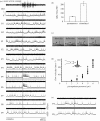Organization and physiology of posterior lateral line afferent neurons in larval zebrafish
- PMID: 20181553
- PMCID: PMC2880066
- DOI: 10.1098/rsbl.2009.0995
Organization and physiology of posterior lateral line afferent neurons in larval zebrafish
Abstract
The lateral line system of larval zebrafish can translate hydrodynamic signals from the environment to guide body movements. Here, I demonstrate a spatial relationship between the organization of afferent neurons in the lateral line ganglion and the innervation of neuromasts along the body. I developed a whole cell patch clamp recording technique to show that afferents innervate multiple direction-sensitive neuromasts, which are sensitive to low fluid velocities. This work lays the foundation to integrate sensory neuroscience and the hydrodynamics of locomotion in a model genetic system.
Figures


Similar articles
-
Physiology of afferent neurons in larval zebrafish provides a functional framework for lateral line somatotopy.J Neurophysiol. 2012 May;107(10):2615-23. doi: 10.1152/jn.01108.2011. Epub 2012 Feb 15. J Neurophysiol. 2012. PMID: 22338025 Free PMC article.
-
Activity of Posterior Lateral Line Afferent Neurons during Swimming in Zebrafish.J Vis Exp. 2021 Feb 10;(168). doi: 10.3791/62233. J Vis Exp. 2021. PMID: 33645560
-
Frequency response properties of primary afferent neurons in the posterior lateral line system of larval zebrafish.J Neurophysiol. 2015 Jan 15;113(2):657-68. doi: 10.1152/jn.00414.2014. Epub 2014 Oct 29. J Neurophysiol. 2015. PMID: 25355959 Free PMC article.
-
The lateral-line and inner-ear afferents in larval and adult urodeles.Brain Behav Evol. 1988;31(6):325-48. doi: 10.1159/000116599. Brain Behav Evol. 1988. PMID: 2843258 Review.
-
The puzzle of hydrodynamic information processing: how are complex water motions analyzed by the lateral line?Eur J Morphol. 1999 Apr;37(2-3):195-9. doi: 10.1076/ejom.37.2.195.4732. Eur J Morphol. 1999. PMID: 10342456 Review.
Cited by
-
There and back again: development and regeneration of the zebrafish lateral line system.Wiley Interdiscip Rev Dev Biol. 2015 Jan-Feb;4(1):1-16. doi: 10.1002/wdev.160. Epub 2014 Oct 20. Wiley Interdiscip Rev Dev Biol. 2015. PMID: 25330982 Free PMC article. Review.
-
The Cholinergic Lateral Line Efferent Synapse: Structural, Functional and Molecular Similarities With Those of the Cochlea.Front Cell Neurosci. 2021 Oct 12;15:765083. doi: 10.3389/fncel.2021.765083. eCollection 2021. Front Cell Neurosci. 2021. PMID: 34712122 Free PMC article. Review.
-
Optogenetic interrogation of the lateral-line sensory system reveals mechanisms of pattern separation in the zebrafish brain.bioRxiv [Preprint]. 2025 Feb 8:2025.02.07.637118. doi: 10.1101/2025.02.07.637118. bioRxiv. 2025. PMID: 39975109 Free PMC article. Preprint.
-
Developmental and architectural principles of the lateral-line neural map.Front Neural Circuits. 2013 Mar 26;7:47. doi: 10.3389/fncir.2013.00047. eCollection 2013. Front Neural Circuits. 2013. PMID: 23532704 Free PMC article. Review.
-
Hair cell identity establishes labeled lines of directional mechanosensation.PLoS Biol. 2018 Jul 19;16(7):e2004404. doi: 10.1371/journal.pbio.2004404. eCollection 2018 Jul. PLoS Biol. 2018. PMID: 30024872 Free PMC article.
References
-
- Alexandre D., Ghysen A.1999Somatotopy of the lateral line projection in larval zebrafish. Proc. Natl Acad. Sci. USA 96, 7558–7562 (doi:10.1073/pnas.96.13.7558) - DOI - PMC - PubMed
-
- Catton K. B., Webster D. R., Brown J., Yen J.2007Quantitative analysis of tethered and free-swimming copepodid flow fields. J. Exp. Biol. 210, 299–310 (doi:10.1242/jeb.02633) - DOI - PubMed
-
- Chagnaud B. P., Bleckmann H., Engelmann J.2006Neural responses of goldfish lateral line afferents to vortex motions. J. Exp. Biol. 209, 327–342 (doi:10.1242/jeb.01982) - DOI - PubMed
-
- Coombs S., Conley R. A.1997Dipole source localization by mottled sculpin. I. Approach strategies. J. Comp. Physiol. A 180, 387–399 (doi:10.1007/s003590050057) - DOI - PubMed
-
- Coombs S., Montgomery J. C.1992Fibers innervating different parts of the lateral line system of the Antarctic fish, Trematomus bernacchii, have similar neural responses despite large variations in peripheral morphology. Brain Behav. Evol. 40, 217–233 (doi:10.1159/000113914) - DOI - PubMed
Publication types
MeSH terms
Grants and funding
LinkOut - more resources
Full Text Sources
Molecular Biology Databases

